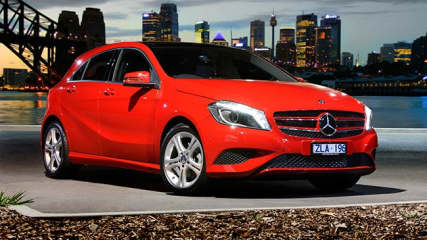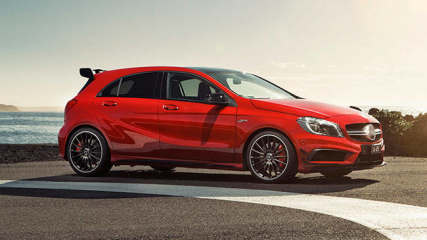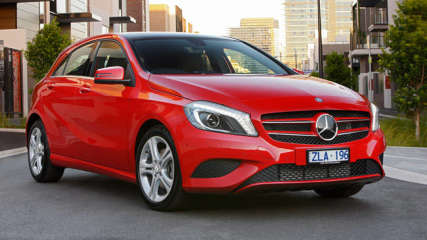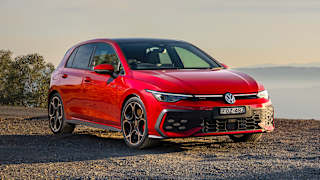Mercedes-Benz A-Class 2013 Review
By Philip King · 26 Mar 2013
After someone asks me what car I'm driving, the next thing they ask is invariably, “What's it like?'' When the answer to the first question is, “a Mercedes'', then the answer to the second one is invariable too: “The older I get, the more I like them.''There are two thoughts at work here. First, that the finely calibrated discrimination of maturity is required to appreciate their qualities; like stilton or single malt, perhaps. But also, and more ambiguously for the brand, that Mercedes are old people's cars.The image of Mercedes as a venerable maker of ponderous limousines is something it has been trying to shrug off for decades. It has no choice because the prestige car market has been changing. Luxury buyers increasingly demand smaller cars and non-luxury buyers increasingly demand, well, luxury.Then there's the issue of tighter and tighter emissions regulations, which are impossible to meet without small cars in your line-up.In some ways Mercedes was an early mover here. Its first crack at the small market was the A-Class from 15 years ago. However, it was not a happy birth. The tall tiddler famously failed a swerve-to-avoid manoeuvre known as the “elk test'', undertaken by a specialist magazine, and needed a PR rearguard action to avoid disaster.“The prospects for premium compact cars have never been better,'' Mercedes boss Dieter Zetsche said when revealing the car last year. “We expect global demand to grow by more than four million units over the next 10 years.''Capturing some of those extra buyers is essential to Mercedes' goal of regaining No 1 spot in luxury sales by the end of the decade. “A stands for attack,'' Zetsche said, with 50 per cent of buyers expected to be new to the brand.At the Melbourne launch local chief Horst von Sanden was confident of selling 200 a month, many more than the previous A and B-Class put together. It will be a challenge for the dealer network, as Merc novitiates would demand the full three-pointed star treatment.“It's very important that we treat these newcomers to the brand like every loyal Mercedes customer would be treated,'' he said. “Although we have some aggressive and attractive pricing, they still accept a premium price, and for that they want something special.''VALUEThat price starts at $35,600, which is lower than the original 15 years ago. It sent a shiver through its rivals. Additional cost reassurance comes in the shape of a $1383 service contract to cover the first 50,000km or more than three years for an average driver. Who says Europeans are expensive to run?Equipment levels, however, would make a Merc buyer of only a decade ago recoil with envy. All cars are fitted with a seven-speed double-clutch automatic, so that's standard, so is useful stuff such as auto headlights and for the spatially challenged, a semi-automatic parking system. There are classy features such as ambient lighting and illuminated door sills.One feature much touted at last year's reveal was a high level of integration with Apple's iPhone. However, this requires a special kit that has yet to be confirmed for Australia. There's Bluetooth, but a $2990 option pack is needed for internet, digital radio and 10 gigabyte music storage.It's clear where costs have been cut. The leather is artificial unless you pay extra -- bundled with other bits it's $2490. Many levels have cheap racket seat adjustment and when the soft textures run out the plastics are any-level hatchback.DESIGNAn accessible price is just the start. Other A-Class lures are a combination of traditional Merc virtues and something new. The design is in-your-face, with large lights and grille the most conspicuous elements of a bulbous front end. There are pronounced style creases along the flanks, very much design du jour, while the rear is anonymous enough to be almost any small hatch. It's bold but not beautiful.The cabin is more successful. The surfaces are clean and uncluttered; there are soft textures at dash level and some below. The wands feel quality; so do the gearshift paddles and satin metallic highlights around door handles and vents. The button-gear and steering wheel are standard-issue Merc, a plus. A crisp control screen looks expensive. The boot looks big enough but the finish is not at mainstream Merc standards.TECHNOLOGYFor 2013, kit debuted only a few years ago on Merc's tech spearhead, the S-Class, has trickled down to the A. Of four engines on offer the turbocharged 2.0-litre petrol is quickest by far but requires buying into the Sport trim and comes with some drawbacks. Its bass soundtrack has a thrumminess at constant revs and the quicker Sport steering is too quick, if anything.SAFETYFor many, Mercedes' reputation for safety will be a wallet winner and the A-Class has form here, having introduced electronic stability control to the segment in 1997. It also has a collision prevention system that alerts the driver and primes the brakes if it senses imminent impact with a car in front at speeds above 30km/h.DRIVINGIts Sport suspension struggles to control body movements on Australian country roads and the ride quality is brittle. The high-output version of the 1.6-litre in the A200 is quieter and slower but easier to live with. It has enough get up and go, and actually sounds terrific when you push it. I preferred the steering and suspension set-up.The 1.8-litre diesel in the A200 CDI won't kid you into mistaking it for a petrol engine, as some do, but it does pull strongly and for long hauls would be worth considering. One problem for all the cars was a bit more tyre noise than expected, a common problem among European imports. It was one reason the A-Class doesn't deliver the serenity you expect in a Merc.VERDICTThere's enough brand feel-good to make this a convincing junior Merc. And as the young brand adopters get older, they'll have acquired a taste for full-strength versions.NEED TO KNOWPrice: From $35,600 (A180) to $49,900 (A250) plus on-road costsEngines: 1.6-litre turbocharged four-cylinder petrol (A180, A200); 1.8-litre turbocharged four-cylinder diesel (A200 CDI); 2.0-litre turbocharged four-cylinder petrol (A250)Transmission: Seven-speed automatic, front-wheel driveThirst: 4.6l/100km combined (A200 CDI); 5.8-6.6l/100km combined (petrol), CO2 135g/km

.JPG)
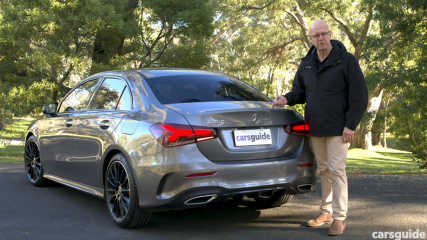

.jpg)

